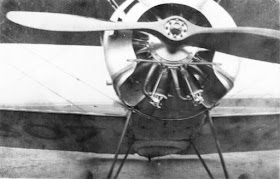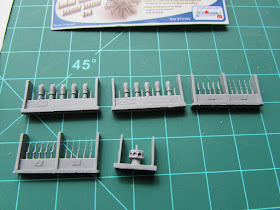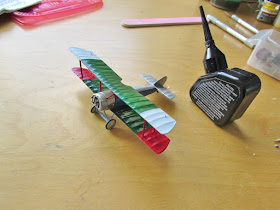http://wingsofintent.blogspot.com/2016/11/sopwith-pup-1921-aerial-derby-arctic.html
Oh, the pleasure of giving a new destiny to a creature seemingly bound to darkness.
The joy of redeeming a lowly, destructive function into a
luminous one.
The Sopwith Pup (sorry to make a slight allusion to canids,
can't be avoided), after the mess of the second decade of the XX century, found
sometimes a nicer way to pass the time, in this case racing.
I found a brief article on the issue #5 of The Aviation
Historian magazine on this little racer that participated in the 1921 Aerial
Derby in England,
with even a drawing of the scheme it had at the time. How could one resist!
The Airfix Pup is surprisingly detailed for a 1973 kit, as
you will see in the photos bellow, and although far from perfect, it's an
encouraging sight, nothing like the abominable Delta 2 MC72 that I am building
in parallel (perpetrated also in 1973), check this abomination:
The kit's engine is quite good, no kidding, but I have been
aching to use one of the superb, incredibly precise and extraordinarily cast
engines of Small Stuff, of which I purchased quite a bit. In this case it's the
Le Rhone 80hp, a sweet kit on itself.
You may read his comment bellow this posting, which refers to a building article that in turn refers to a magazine. You will see the suggested corrections as we advance.
What Z sent:
Nice fuselage detail, stitching and such. The racer differs a bit, and light mods will be needed:Stomach-ache pilot and nice engine:
Even jigs to align the wings!!
Cowl with some detail. Again, the racer's is different:
Internal detail, everywhere but where it would be seen. Appreciated, nevertheless:
Not bad for a 1973 mold, uh? (this is a re-issue):
Even inst. panel and seat:
"Canvas" surface, control horns, a bit overstated of course, but commendably thin surfaces:
The location of the strut devices will have to be filled, as well as those ejector pin marks, ever-present:
The molded-in control horns are removed -they will later be replaced by metal ones- and the ones facing the inter-wing space are redundant since the ailerons were interconnected. The half-pyramid cut on the front/bottom of the fuselage recommended in the article. As I did with other similar Airfix kits, I filled-up the recesses for the strut-bridging locating devices. A .040 x .020 styrene strip is a perfect match. The ejector pin marks are filled at this stage:
The cowl modifications are started. A section is cutoff:
Some thinning:A lateral slot is carved, as well as four tiny "windows", lopsided as per original. I managed to break the inner edge of two of them trying to use a file, and had to make a repair with styrene bits:
Four really tiny darn hellish louvers are cut from thin aluminum sheet, bent appropriately -with angled sides- and glued. Phew, is all I can say, after many, many tries at cutting, bending the edges and gluing them:
All flying surfaces have now their control horns removed and ejector pin marks filled, plus the "canvas" and ribbing exaggerated effect subdued by sanding:
The ejector pin marks are removed from the fuselage sides:
Some interior is concocted. Floor, seat, rudder and joystick go on the lower wing, and some frame and wires are added to the fuselage sides. Still to install are the instrument panel, throttle, a pump to make things look a little busier:
Some more elements, some color, a wash. The prop still needs it's tips painted canvas color:
The Fuselage sides are glued together, and the lower wing added. The triangular excision is visible:
A piece of stretched styrene is used to plug an unnecessary hole for this version, and a small piece is used to fill a gag on top of the instrument panel:
The racer had the very last section of the fuselage uncovered, perhaps to provide easy access to the tailskid anchoring or kingpost. Two cuts are made to remove a section of the plastic:
The plastic is carefully scrapped away and a kingpost glued:
The stiffeners are added to the cowl. Once more: the Aviation Historian plan and the restored plane have more than the ones contemporary in photos. The real plane had 4, whilst 6 are wrongly depicted:
A metal plate from a Tom Modelworks photoetched set is added:The Pitot on the strut must be removed. The Aviation Historian plan is inaccurate in that respect. The Pitot was mounted on the original plane on the upper wing, aligned with the strut, as per contemporary photos:
A headrest is added to the model, cut from a section of styrene rod:
The cushion is also fashioned, to be added later:
The belly of the beast is puttied and tidied-up in preparation for the primer:
The landing gear legs have the horizontal small spacer removed and a new "T" frame added. Two thin rods are glued to the axle's sides:
As I said above, the kit's engine is surprisingly (for the time) good. However, Small Stuff Le Rhone 80hp is on category of its own. More than reasonably priced, and with a level of detail and precision that seems impossible, I ordered a couple:
I started by gluing one cylinder, then the spark plug to it, proceeding anti-clockwise in order to have space to be able to comfortably add the spark plug:
After a while, and even when you get one of each and every part as a bonus, I managed -due to my not so good sight- to lose all my spark plugs, and then started to superglue stretched sprue on the corresponding hole and trim it once set. Worked for me:
All the cylinders are in place. Still to go are the pushrods and intakes:
Oh, my...modeling conundrum. The Small Stuff engine (here seen with two pushrods already glued) is the right size. The kit's engine is well detailed, but entirely the wrong size, having been designed smaller to be able to rotate inside the thick cowl. Now of course the Small Stuff engine won't fit inside the cowl. So, possible solutions: a) Make another cowl for the engine; b)Trim the part of the engine (upper) hidden by the cowl and leave alone the exposed area (lower), which will prevent the engine from spinning with the prop as a rotary would; 3) Leave the cowl out as in a diorama. We'll see...
The Small Stuff engine is completed, showing the sizes comparison and extreme detail. The engine requires patience (did it in several sessions) and good sight. I have little of the former and none of the latter, but managed, not without some fuzzing:
The landing gear is added. The rudder metal control horn is added and the elevators are located in a "relaxed" position:
An horizontal reinforcement and structural curved tube seen on the cowl are added:
The painted Small Stuff and kit's engines. Even if the crankcase portion of the engines is the same size, it is more evident now that the kit's cylinders are pitifully short and small, to be able to clear the thick walls of the injected plastic cowl:
Photoetched control horns are glued to the corresponding surfaces. Beware that on the wings they are only located on top of the top wing and bottom of the bottom wing. The ailerons were united by cable in a loop (holes for cable already drilled):
The major sub-assemblies ready for priming:
Primer is applied:
Metallic colors are airbrushed. Aluminum for the cow and fuselage front, white aluminum for the tail group and fuselage back:
The aluminum colors are masked and the white of the lower wing bottom is painted white, whilst the upper wing bottom is painted canvas. Both wings top surfaces are also painted white, since the upper wing tips had it that way and as a base for the red color on the lower wing tips. More masking and painting will ensue, since the light blue, red and green all have to be applied:
More masking and more painting continues:
Still to go: the green on the lower wing, the red on the lower wing tips and other details on the cockpit area:
Green applied on lower wing:
And now all else shall be masked to apply the red on the tips and cockpit area:
Masks are set to apply the red color:
The struts are painted at this time since they seem red too in photos:Still some details to go, like red stripes on the fuselage sides and in front of the light blue color.
I departed a bit from the references here, since I believe that the canopy area was red, and not just the headrest, based on one photo showing the plane after the crash. It is most definitely not light blue as the sides, as shown in the magazine article recreation:
The belly of the little pup:
The sub-assemblies:
A project in parallel:
Red stripes decals on fuselage on. Also windshield, two sort of exhausts on the side of the nose, headrest and tail group:
Control leads and rigging installed on the tail. Phew! oh my eyes (working at nighttime):
Today I went to the optometrist, nice chap, good prescription. But I am still lacking vision superpowers:Wheels and landing gear rigging in place:
The wing struts are glued in place, but without cutting off their "bridge" (the space for that horizontal length was filled-up on the upper wing), to keep alignment. Once dry the bridges will be removed:
The top wing in place, as well as the engine and cowl:
I ended up using the kit's engine for the sake of simplicity, but I'll
pose the much better Small Stuff engine aside it when complete -on a rig or working
table-, as if the engine were about to be exchanged:Still to go: propeller, rigging and the decals from Arctic Decals:
A trestle is made to prop the Small Stuff engine aside the model:
The engine is given a couple of details on the back to represent it complete:
Ready to pose:
Still to go: the wing rigging and aileron cables, to be done once the decals are applied -when they arrive-
Rigging in place:
Sunset in place:
A Fotocut Pitot set is prepared to be added to the model. The probe DOES NOT go on the strut as usual -or indicted in the magazine plane-, but on the leading edge above the strut on the racer:
Arctic Decals from Mika Jernfors arrived! They are exquisite, as usual:
Decaling is completed, but decals have yet to set and some additional rigging is needed too. Tomorrow, may be:
Another Pitot is made. This should be located on the wing on top of the right strut (following actual photos), and not on the strut itself as in the magazine plan:




















































































The Airfix Pup came out originally in 1975, moulded in cream plastic in
ReplyDeletea blister pack (I still have several...). The one you have there is a much later re-pop. See also here:
http://www.internetmodeler.com/2005/april/aviation/Pup.php
Dear Roger
DeleteOnce more, thanks for the useful additional information and references.
Best regards
That cowl you have depicted with the
ReplyDeletecut outs, etc,is the one usually associated with the more powerful 100hp Gnome engine (not the common 80hp Le Rhone), which I guess is logical for a 'racing' aircraft.So you may want to check you have the correct engine....
I am afraid that's not correct, Roger.
DeletePlease refer to the posting where I will upload the pertinent images to prove the point.